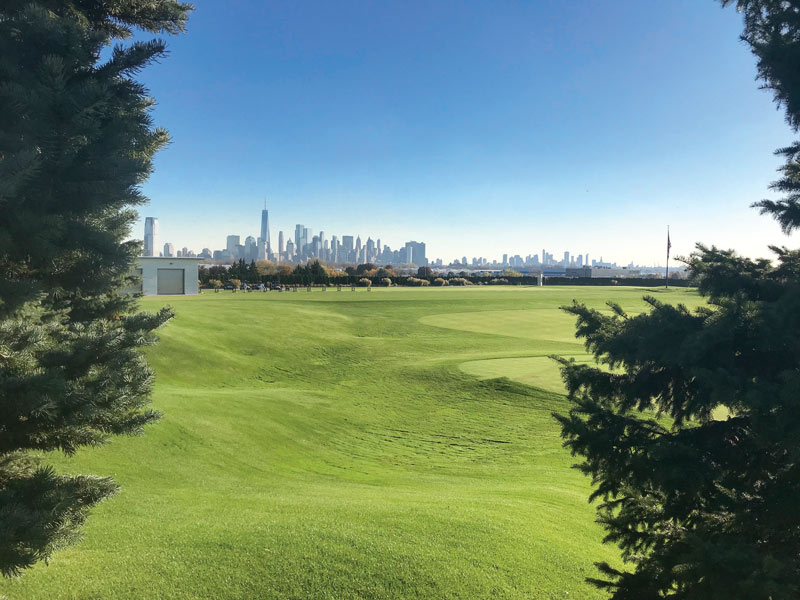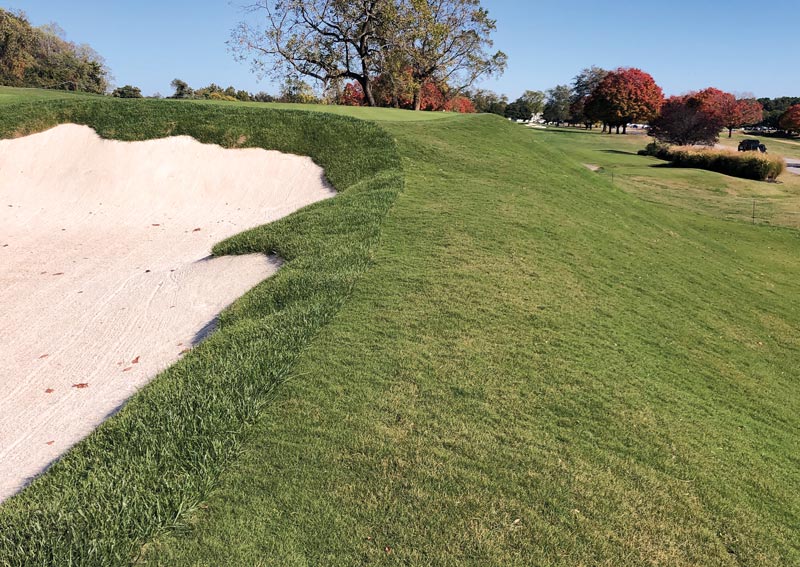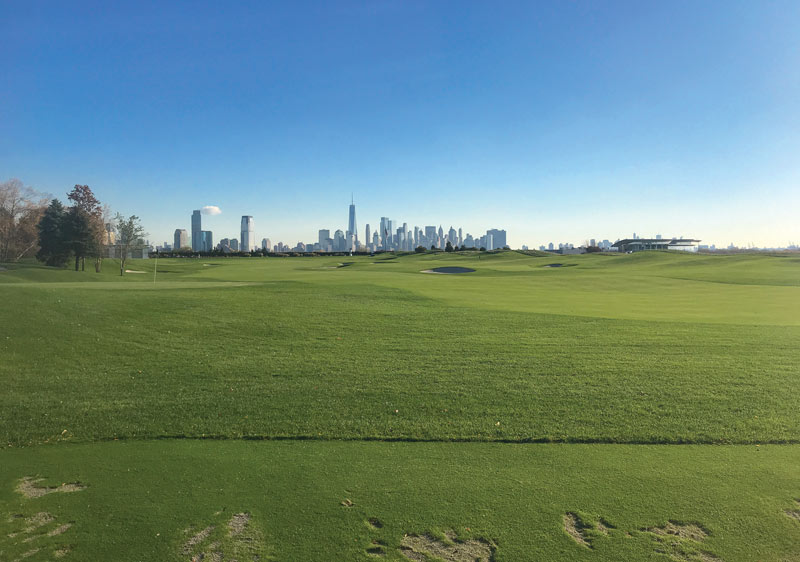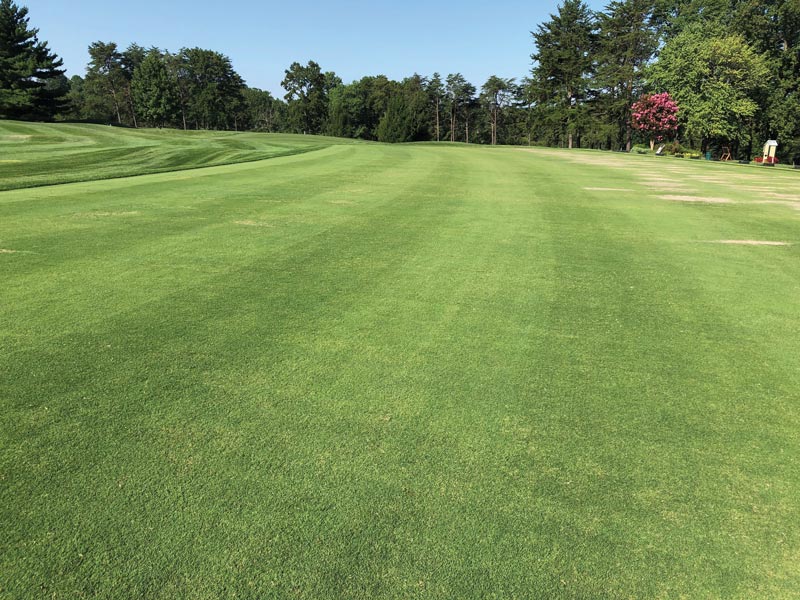
In a break from convention, Liberty National Golf Club in Jersey City, N.J., and its longtime superintendent, Greg James, recently changed the grass on the club’s driving range tee to Tahoma 31 bermudagrass, a warm-season variety known for its cold tolerance. Photo courtesy of Greg James
Liberty National Golf Club is known for many things — views of the Statue of Liberty and the Manhattan skyline; hosting the PGA Tour for The Barclays, The Northern Trust and The Presidents Cup tournaments; and its celebrity members like Justin Timberlake and Mark Wahlberg. Up until now, bermudagrass wasn’t on that list.
Located in Jersey City on the edge of New York Harbor, Liberty National has had bentgrass greens, fairways and tees since its 2006 opening. But earlier this year, golf course superintendent Greg James planted a new cold-tolerant bermudagrass, Tahoma 31, on his driving range tee. James, who grew-in the golf course and has been Liberty National’s superintendent since 2005, says there was a definite method to the madness in the decision to plant a warm-season grass in a cool-season climate.
“When we first opened up in 2006, our membership was small, and over the years, the club membership grew,” says James, a 34-year GCSAA member. “Now we’re up over 260 members, so the driving range tee has gotten a lot of use. It was hard to keep up the bentgrass on the tee itself due to the use it was getting. I decided not to overseed with ryegrass into bentgrass because it doesn’t look that good.
“My friends Paul B. Latshaw (CGCS) at Merion Golf Club and John Gosselin at Aronimink Golf Club (both in suburban Philadelphia) have Latitude 36 on their range tees, and they said it was pretty successful there and easy to take care of. And then I heard about a new variety, Tahoma 31, which was this new variety of cold-tolerant bermudagrass out of Oklahoma State. My friend Russ Myers was putting it around his greens at Southern Hills. So I said, ‘If he can grow it in Tulsa, I don’t see why I can’t grow it in Jersey City.’”
James planted the grass in March 2019, and the PGA Tour hit balls off it this past summer during The Northern Trust, the first stop of the FedEx Cup Playoffs.
“We had a lot of favorable comments on it from the Tour agronomist and others,” James says. “Everybody thought it worked out really well.”
Does James think he could ever plant bermudagrass on his fairways? No. But James says it’s a viable solution to combat heat and wear on his driving range during peak season, when he really needs it. James put a cover down and closed the range tee in mid-October. The course closes in December and remains so until spring.
Earlier green-up, drought tolerance and more
While the bermudagrass at Liberty National will be covered all winter, just a little farther south down I-95, at the Naval Academy Golf Course in Annapolis, Md., the bermudagrass will remain open to the elements year-round.
The 18-hole military course is undergoing a major renovation. “I’ve been here for two years now, and I’ve just been trying all sorts of things because I knew we were going to renovate the course, and I wanted to figure out what was going to be the best,” says Eric David, GCSAA Class A superintendent at the Naval Academy Golf Course and a 10-year member of the association.
In the first part of the renovation, the bentgrass/Poa push-up greens built in the 1940s were converted to USGA greens grassed with 007 bentgrass. In May, about 20,000 square feet of Tahoma 31 was planted on a par 3 and some tees. David had already had experience with bermudagrass on his course, with Latitude 36 “that’s about 10 years old” in the practice area and on a couple of tees.
The fairways and tees at the Naval Academy GC had been renovated in the mid-1990s with a winter-hardy bermudagrass called Vamont (originally released in 1980), and they will be renovated next spring with Tahoma 31 bermudagrass. Green surrounds will be grassed with HGT Kentucky bluegrass, and approaches were sodded with Tahoma 31 in October. David doesn’t plan to overseed any of it.
“The reason we’re going with these newer varieties of bermudagrass is because the Vamont takes almost into the end of June/July before it actually starts turning green, and these new hybrids, they start turning green at the end of April if we have a decent spring,” David says.

The renovation project at the Naval Academy Golf Course in Annapolis, Md., has introduced Tahoma 31 bermudagrass to several areas of the course, including this rough area. Photo courtesy of Eric David
Having a mix of cool- and warm-season grasses makes David’s maintenance program a lot easier. “It’s really nice because the cool-season that I manage is basically just my greens and green surrounds. The rest of it is all warm-season,” he says. “And so our chemical usage is far less than anybody I know who has cool-season fairways and cool-season roughs. We don’t have to use a lot of fungicides or anything because we just don’t need to. We use far less water because we don’t really water very much on the fairways. We use probably a little bit more fertilizer than the cool-season guys do, just in the middle of the summer.”
This past summer, during the renovation, David witnessed drought tolerance he says he never could have achieved with a cool-season grass.
“During the renovation, we had to shut the water off on one of the tees that had Tahoma 31 on it. We did not have water on it for four weeks, and we’d been in a pretty good drought here for the last two months. We hadn’t had any rain, and it was 100% playable — still green and hadn’t had water in about four weeks. That’s one of the things I’m most impressed about (the drought tolerance), because we just don’t have to water it,” David says.
What’s behind the change?
It appears more and more superintendents in the northern parts of the transition zone and beyond are now considering warm-season grasses to be an option. Just a few years ago, it would have been unthinkable. Could we be transitioning the transition zone?
Yanqi Wu, Ph.D., is the Meibergen Family Endowed Professor in Plant Breeding at Oklahoma State University. Wu’s turfgrass breeding program has developed several cold-tolerant bermudagrasses, including NorthBridge, Latitude 36 and Tahoma 31. According to Wu, there are six key reasons warm-season grasses are now being used farther north:
1. Climate change. Wu says the warming climate is reflected in the most recently issued changes to the plant hardiness zones map. The warmer zones climbed farther north, “anywhere from 100 miles to 200 miles,” Wu says. “They called it a half-a-zone move-up because of climate warming.”
2. Water use. Warm-season grasses such as bermudagrass use 25% to 30% less water than cool-season grasses, Wu says.
3. Disease. Warm-season grasses, though not immune, are less susceptible to disease than cool-season grasses are.
4. Aggressive growth pattern. Especially on tee boxes, Wu says, warm-season grasses such as bermudagrass recover from divots faster than cool-season grasses do.
5. Turfgrass breeding. Programs such as those headed by Wu at Oklahoma State and Ambika Chandra, Ph.D., at Texas A&M University have created genetic improvements through breeding that make for stronger, more cold-hardy varieties.
6. Climate variability. Not just warming, but unpredictability — wild swings from hotter summers to colder winters — has led superintendents to look for new turfgrass options. Wu says building in cold tolerance “equal to reduced winterkill potential” is a focus of his research.
Zoysias stake their claim
While Wu works with bermudagrasses, Chandra’s focus is on cold-tolerant zoysiagrasses. Chandra cites fewer inputs — less water and fertilizers — as the main benefits of switching from cool-season to warm-season grasses in the transition zone.
“This is another alternative and option for turfgrass managers in the transition zone who are looking for environmental stewardship, or they want to have really good playing surfaces and they have to achieve that with limited budgets. Warm-season grasses become a very important and viable option for them,” Chandra says. “I’m not trying to say that this will fit every scenario on every course and every budget. There’s a place for these grasses, and now, with new varieties, the superintendents have better options.”
Innovation zoysiagrass is the first cold-tolerant variety out of Chandra’s turfgrass breeding program, and it’s a joint release with Jack Fry, Ph.D., of Kansas State University.
“We’ve had so much interest in the golf industry for Innovation zoysia,” says Joe Bammer, president of GrassMasters Sod Farm in Patoka, Ind. “It’s very cold-tolerant. It’s fine-bladed like Zorro or any of the new fine-bladed zoysiagrass. And it makes a great sod — better than anything I’ve seen as far as zoysiagrasses go. We’re sold out now, and I think we’re gonna be sold out for a while.”
In business since 1997, GrassMasters has grown both warm- and cool-season grasses “from day one.” GrassMasters grows Kentucky bluegrass and tall fescue, as well as Innovation zoysia, NorthBridge, Latitude 36 and Tahoma 31 bermudagrasses for their cold tolerance. Bammer has shipped grass to the Indianapolis Colts, the Tennessee Titans, Indiana State University and golf courses all over the Midwest.
“We’re in a transition zone, so a lot of our warm-season grasses are going to golf courses and athletic fields, more so now than ever,” Bammer says.
Andy Perry, territory manager with sod producer Buy Sod, heads up a test-site program to put some of the new zoysia greens varieties developed by Bladerunner Farms into test greens in North Carolina, Tennessee and Virginia.
“Prizm, the new zoysia for greens ... we have seen that go through winters at Pine Needles Golf Course in Pinehurst, N.C., two years ago at 5 and 8 degrees,” Perry says.
Testing continues to push the limits of how far north some of the new warm-season varieties cannot only survive but thrive. “We won’t be at the Canadian border, but I think the zoysias will keep moving northward,” says David Doguet, president of Bladerunner Farms, which is based in Texas.
The trend to adopt warm-season grasses in cool-season climates is not confined to the United States. “We are grassing golf courses in traditionally cool-season regions of China and South Korea with zoysias because they have lower maintenance requirements while providing a high-quality surface,” Doguet says.

Heat stress and heavy peak-season use of the driving range tee at Liberty National Golf Club prompted superintendent Greg James to try a warm-season grass. Photo courtesy of Greg James
After 80 years in business growing strictly cool-season grasses, Tuckahoe Turf Farms, a sod producer in Hammonton, N.J., is now growing a warm-season grass, Tahoma 31. Allen D. Carter Jr., business administrator at Tuckahoe, cited “climate adjustment” as one reason he’s comfortable growing a warm-season grass. “Our summers seem to last longer, with more consecutive hot days,” Carter says.
And he’s not the only one who thinks so. Carter says he has received multiple calls about the product from superintendents in the area who want to try it. Still, New Jersey winters are cold. “This bermuda, Tahoma 31, has the best winter-tolerance results,” Carter says.
One size does not fit all
Cale Bigelow, Ph.D., is a professor of turf science and ecology at Purdue University, located in West Lafayette, Ind. He has noticed a conversion to warm-season grasses at some of the ballfields at Purdue, as well as at sports complexes off-campus.
“Turfgrass breeders, particularly those working on bermudagrass, have really made some very strong developments in the cold hardiness, cold tolerance piece of everything,” Bigelow says. “And then you tie in what people are expecting of these grasses, particularly late in the season — August, September, October — which usually coincides with some of our recreational sports, you know, high school sports, and there might even be a little bit of golf. Then, if you want to buy into some of the weather data and the trends toward warmer falls and springs, it does lend itself to this idea that we maybe need to be planting some of these warm-season grasses a little bit more, just in terms of turfgrass persistence.”
Bigelow was clear that not all bermudas are adaptable to life in cool-season regions. There are real differences among varieties. Bigelow’s program at Purdue participates as a test site for the National Turfgrass Evaluation Program. In the spring of 2013, Bigelow planted 42 bermudagrass strains at his test site. The trial ran from 2013 through 2018, during which time Bigelow documented the range of cold hardiness among bermudagrass cultivars.
“That was the year of the polar vortex, that winter of 2013-2014. And in that year, the spring of 2014, only nine of those 42 bermudagrasses had 50% or more ground cover by about the first week of June,” Bigelow says.
By the end of the study, Tahoma 31, the grass at Liberty National in New Jersey, had emerged as the most cold-hardy variety by far. In West Lafayette, Tahoma 31 had only 4% winterkill, while the variety TifTuf, for example, had 82% winterkill, and Latitude 36 had 41% winterkill. The closest performer to Tahoma 31 was Patriot at 11% winterkill.
What’s ahead in the transition zone
At the 36-hole Baltimore Country Club at Five Farms in Timonium, Md., Tim Kennelly, CGCS, is taking a wait-and-see stance. Like Liberty National, his range tees were taking a beating in the summer with cool-season grasses. As a test, over the past two years, he has sodded a few tees with Riviera, Latitude 36 and Tahoma 31.
“We’ve got a little bit of everything out there. We’ll figure it out, kind of see what happens, what they look like year-round, how they come through the wintertime and how they hold up in the summertime,” says Kennelly, a 38-year GCSAA member.
Around the club’s pool deck, Kennelly relies on an older warm-season grass, Meyer zoysia. “The grass is really soft,” he says. “We don’t have to mow or water it quite as much, and it tolerates the traffic really well. We have about an acre inside our pool ground.”

Baltimore Country Club at Five Farms in Timonium, Md., has seen success with warm-season surfaces in a few places around the property and is giving them a go on driving range tees. Photo courtesy of Tim Kennelly
Chad Adcock was a superintendent for the first two decades of his career, half of which he spent managing cool-season grasses, the other half growing warm-season grasses. Adcock was the director of golf and landscape maintenance at Kingsmill Resort in Williamsburg, Va., before he joined Sod Production Services — the company that licenses Tahoma 31 for Oklahoma State University — in 2017.
“I think the trend has to do with warmer summers farther north, and that cool-season turfgrasses have always struggled with sports injury during the summer,” Adcock says. “The fact is that these newer bermudagrasses can go further north, are greening up earlier and going dormant later, and they’re withstanding the sports traffic far better than the cool-season grasses can.”
In the end, it all comes down to dollars and cents. “Golf courses have less money in their budget every year, it seems like, to apply fungicides and things like that on their cool-season turfgrasses,” Adcock says. “And now, with the increased drought tolerance and winter hardiness of the bermudagrasses like Tahoma 31, superintendents can basically replace bentgrass in certain areas.
“These warm-season turfgrasses are so much better at tolerating cold, with improved winter survivability, earlier spring green-up and later fall dormancy, that these grasses provide outstanding opportunities for golf courses to save money.”
Stacie Zinn Roberts is an award-winning writer, marketing expert and founder of What’s Your Avocado? Marketing and Public Relations in Mount Vernon, Wash., which specializes in turf and green industry marketing.